The WaterSense Current Summer 2007
In This Issue III, Summer 2007:
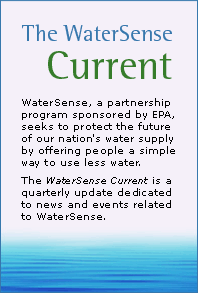 |
In This Issue: |
July Is Smart Irrigation Month

Everyone knows that July is the month for parades, fireworks, and celebrating our nation's independence, but are you aware that July is also the peak water-use month in the majority of states across the country? To help homeowners, communities, and businesses better understand why and how to use less water when watering, the Irrigation Association, a WaterSense partner, has designated July as Smart Irrigation Month.
Smart Irrigation Month presents an opportunity for the irrigation industry to communicate to consumers the importance of updating their irrigation systems, learning more about water conservation, and hiring a WaterSense irrigation partner to design, install, and maintain water-efficient systems.
Nationwide, landscape irrigation is estimated to account for roughly one-third of all residential water use, totaling more than 9 billion gallons per day—a figure that can climb much higher as homeowners maintain lawns during the hot summer months. As part of Smart Irrigation Month, WaterSense and the Irrigation Association are offering these five tips to help homeowners improve outdoor irrigation efficiency:
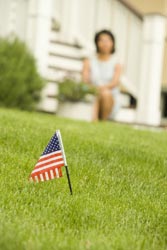
1. Water smarter, not harder
EPA estimates that more than 50 percent of landscape water is lost due to evaporation, wind, or overwatering. If you water during the heat of the day, for instance, as much as 30 percent of the water will be lost to evaporation alone. To maximize both water savings and your lawn's health, coordinate watering with the weather—watering on cool, windless mornings is best. While watering, make sure to saturate the turf's root zones, and then let the soil dry. Watering too frequently can result in shallow roots and make your lawn vulnerable to disease.
2. Ready, aim, sprinkle!
Sprinklers that water more pavement than grass are wasting water and money! Whether you have a standard hose-fed sprinkler or an automatic irrigation system, make sure that the water goes to where it's needed most. Different parts of your yard have different water needs, so you should take into account sun exposure and your plants' water needs when setting up your irrigation system.
3. Less is more
Invest in a micro-irrigation system to water plants, trees, and garden beds. Compared to conventional sprinklers, micro-irrigation systems, such as drip hoses, use 20 to 50 percent less water by minimizing evaporation, runoff, and overspray.
4. Automate your estate
Not sure when your lawn or garden needs to be watered? Consider installing soil moisture sensors or weather-based controllers to help streamline and simplify the watering process. These devices ensure that your landscape is perfectly watered by adjusting your irrigation schedule to changing soil moisture and weather conditions.
5. Hire a WaterSense irrigation partner
The smartest way to save the most water and money is to hire a WaterSense irrigation partner to audit, design, install, or maintain your irrigation system. These irrigation professionals have successfully completed a WaterSense labeled certification program that emphasizes water efficiency, so they bring targeted expertise to the job.
Learn more about other water-saving tips.
Attention Shoppers: WaterSense Labeled Products Hitting Shelves Soon
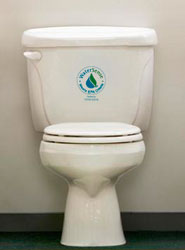
More than 30 models of high-efficiency toilets (HETs), the first product category to earn the WaterSense label, are now labeled and available for purchase. Consumers will now have better toilet choices that protect our water supply without sacrificing performance. Your plumber, retailer, or local plumbing supply store can easily order any of the WaterSense labeled toilets, and several models will be available in retail stores later this summer.
Contrary to popular myths that less water leads to poor performance, these WaterSense labeled HETs get the job done. Improvements in design and technology since the first generation of “low-flow” toilets in the early 1990s mean that today's HETs bear little resemblance to their predecessors. These toilets are independently tested to meet performance standards as well as efficiency criteria, which means they use less water than standard 1.6 gallons per flush (gpf) toilets—and when compared to older models, the savings really add up! Learn more about WaterSense labeled HETs.
As with all toilets, WaterSense labeled HETs will be available in a range of price points. And with water savings, as well as rebates of $25 to $175 offered by many local utilities for replacing older toilets, an HET can pay for itself in only a few years. In fact, the average family of four could save approximately $2,000 over the lifetime of a new HET by replacing just one older-model toilet.
Check out the most current list of HETs that have earned the WaterSense label for efficiency and performance, and then check with your plumber or a retail store near you.
Partner Profile: San Antonio Water System
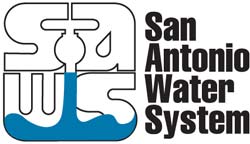
Who knew that flushing a potato could bring about such success? That's what new WaterSense partner San Antonio Water System (SAWS) discovered with its “Kick the Can” toilet giveaway program. In the first quarter of 2007 alone, SAWS gave away 15,000 high-efficiency toilets (HETs) in its service area, creating one of Texas' most progressive water-efficiency programs and helping customers reduce their water bills. SAWS attributes much of the program's popularity to an online video clip that demonstrates the flushing power![]() of the free HETs by flushing a full-sized Russet potato without a hitch.
of the free HETs by flushing a full-sized Russet potato without a hitch.
The Kick the Can program, which began distributing HETs in January 2007, offers SAWS's residential water customers up to two free Caroma Sydney 305 dual-flush HETs per household. Customers can rest assured that these HETs are both water-efficient and high-performing, as the Caroma Sydney 305 recently earned the WaterSense label. SAWS has offered toilet rebate programs in the past, but it found that close to 80 percent of participants were replacing toilets only because they were broken, and not because they were inefficient. Today's program combines offering free HETs with education about superior performance. As a result, SAWS has seen its retrofits climb from 5,000 in 1998 to 19,000 in 2006. SAWS anticipates distributing more than 30,000 HETs in 2007.
Even more important to the program's success is its community-based marketing system. The program, called “Season to Save,” pairs nonprofit community organizations, such as church groups, Boy Scout troops, and homeowners associations, with SAWS to help it market its HETs. Members of these organizations go door to door from September to December to enroll customers who live in homes built prior to 1992. The organizations earn $25 for each toilet they help to distribute, often earning tens of thousands of dollars for their efforts. “Seventy organizations participated this past year,” said Eddie Wilcut, conservation manager for SAWS. “We couldn't do this without the partnerships.”
On the commercial side, SAWS has performed 60,000 apartment retrofits since 1998 and has now retrofitted every school, college, and university in the San Antonio area. Additionally, 1,200 restaurants and three hotels have participated in the program. SAWS executed a turnkey project with the Hilton Palacio del Rio, a high-end hotel that had been experiencing problems with its toilets. Hilton completely retrofitted the Palacio del Rio with HETs from SAWS and hasn't had a problem since. SAWS hopes that the growing success of its HET retrofits will encourage more commercial properties to participate in the program.
SAWS is also working to share its success and spread the word, and it has already collaborated with utilities in Austin, Dallas, and several other municipalities. As a new WaterSense promotional partner, SAWS will now have many opportunities to communicate its lessons learned. For now, it is safe to say that SAWS has its hands full. “The other day, traffic was backed up a mile to get the toilets,” Wilcut said. “We know that eventually the program will have done what it's intended to do and should move on. But we don't want anyone to step up later and say ‘We didn't know about that.' We want every door to be knocked on at least once.”
WaterSense Labels Two Certification Programs for Irrigation Auditors
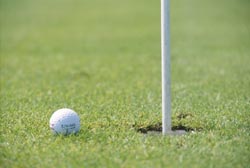
Fore! With the recent additions of the Irrigation Association's (IA's) Certified Golf Irrigation Auditor and Certified Landscape Irrigation Auditor programs, the number of WaterSense labeled professional certification programs is up to four. In May, these programs joined two other previously labeled IA programs—an irrigation contractor and an irrigation designer program—in earning the WaterSense label. WaterSense is excited to announce its new partnerships with landscape and golf irrigation auditors who are certified through these programs to provide quality service for residential, commercial, and golf irrigation system audits.
Professionals who passed exams for either of these auditor programs after April 1, 2007, are eligible to apply for WaterSense partnership. Auditors who passed exams prior to April 1, 2007, are eligible for partnership upon renewal in 2008. As these irrigation auditors become WaterSense partners, consumers will soon be able to search our online listing to find a local partner nearby.
An irrigation auditor can:
- Analyze landscape or turf irrigation water use
- Make maintenance recommendations
- Perform water audits
- Develop irrigation base schedules
A system audit is an important part of maintaining an irrigation system and should be performed periodically to check for malfunctions and to ensure efficient watering. When performing an audit, a WaterSense irrigation partner will run a series of procedures to collect and compile data that show how uniformly an irrigation system is distributing water. WaterSense irrigation partners can then provide customers with suggestions and recommendations for saving on water bills, as well as achieving greener, healthier golf courses or lawns.
Featured Product: High-Efficiency Bathroom Sink Faucets and Accessories
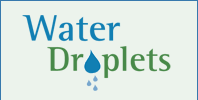
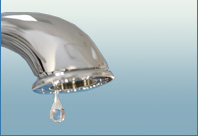
What greets you every morning when you brush your teeth and will soon bear the WaterSense label? High-efficiency bathroom sink faucets and faucet accessories! EPA is pleased to announce that it has developed a draft specification for these products to receive the WaterSense label. Once the draft specification is finalized later this year, manufacturers will be able to start certifying their faucets and faucet accessories to bear the WaterSense label. You should be able to find WaterSense labeled faucets and faucet accessories, such as aerators and laminar flow devices, on retail shelves starting in 2008!
WaterSense Labeled Faucets and Accessories by the Numbers
- 1.5: Maximum flow rate of WaterSense labeled faucets and accessories in gallons per minute (gpm).
- 32: Percent decrease in flow rate from standard bathroom sink faucets.
- 570: Gallons of water a household could save annually by retrofitting bathroom sink faucets to meet the draft WaterSense specification.
- 11 or 13: Months it would take to recover the cost of a WaterSense labeled high-efficiency bathroom sink faucet through water and energy savings (11 months for electric water heating systems, 13 months for natural gas water heating systems).
In keeping with the WaterSense philosophy to label products that are at least 20 percent more efficient than conventional models, the proposed flow rate for these faucets and faucet accessories is set at 1.5 gpm—a 32 percent reduction from the standard bathroom sink faucet flow rate of 2.2 gpm. For homes that do not need new sink installations, aerators are sold for a few dollars apiece at local retailers and can easily be used to retrofit existing faucets to meet the draft WaterSense specification and save you water and money. Both bathroom sink faucets and faucet accessories with the WaterSense label will perform well, even in homes with low water pressure.




